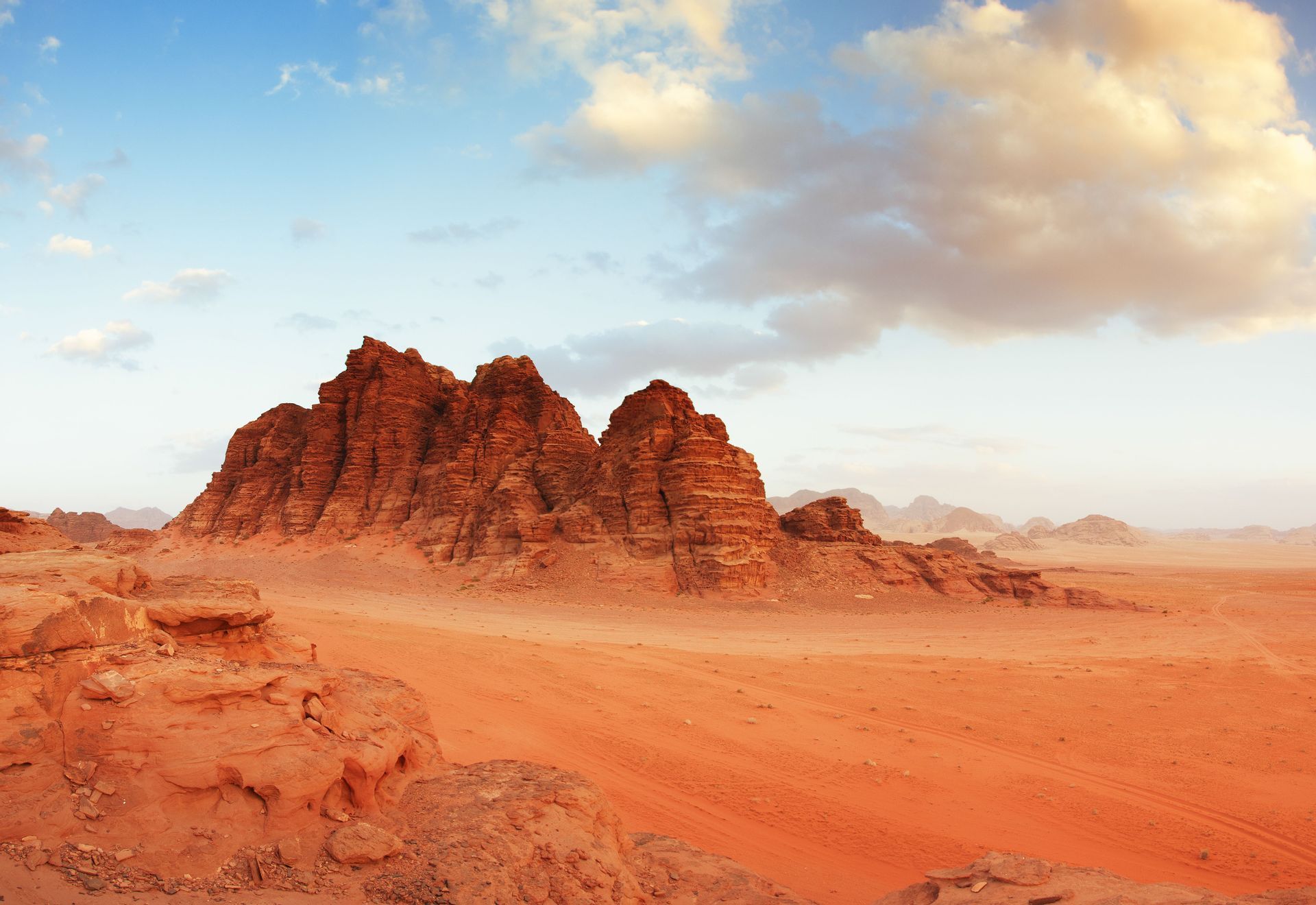
Jordan: land of history and desert
Check out all our itineraries
Our trips to Jordan
This is Jordan: a leap into antiquity in the Roman ruins of Jerash and the Nabatean ruins of Petra, an adventure in the Wadi Rum desert, a float in the Dead Sea and a dive in the Red Sea, chickpea hummus and falef, smiles and great hospitality.
Jordan: a land of trade
Everything you need to know
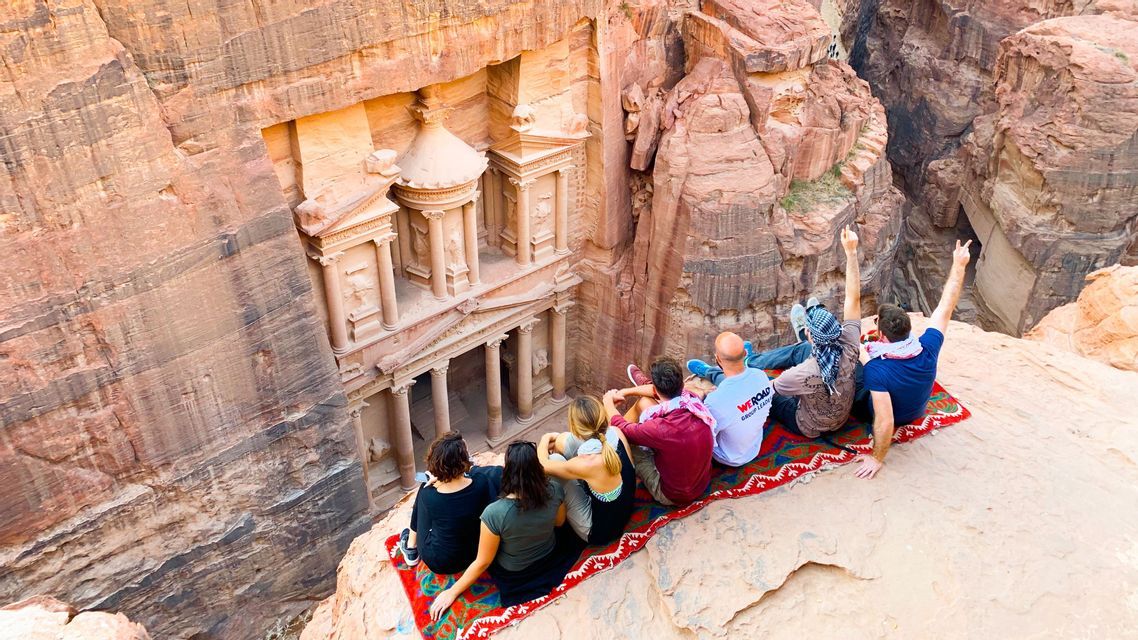
A country that extends in longitude, dividing the European continent from the Asian one, touching the main salidas to the sea: this is Jordan, from the ancient land of trade of traders who bring specialities, tejidos, artesanías to Europe from this country. As you explore Jordania, this mix of cultures will burn and lift you from the Roman ruins of Jerash to the Nabatean ruins of Petra. A mostly rocky and sandy land will welcome you, with the desert of Wadi Rum that has been converted into film platforms like Mars, Indiana Jones or Dune, but whose people are extremely comfortable. Its coasts are bathed by the Dead Sea and the Red Sea, the first - a lake to be told verdad - deprived of life, neither viruses nor bacteria bear its salinity, the second vibrant with colorful fish that inhabit the coral barrier.
When in Rome do as the Romans do
We often tend to associate the political situation of Jordan with that of neighboring Israel and ask ourselves: is it safe to go to Jordan? The answer is yes, for centuries Jordan has been a land of passage for merchants who imported spices and fabrics from the East: coexistence between people of different ethnic groups and religions is a centuries-old local tradition for this very reason and tourists are always welcomed with open arms. In Amman you will see Muslims, Christians and Jews coexist, despite the fact that the majority of the population is of the Islamic faith. Female tourists are not required to wear clothing other than what they are used to, but as guests of this country, it is always nice to remember that it is good practice to show respect for the local culture and tradition and small precautions such as avoiding exaggerated necklines, bare shoulders and short skirts or shorts are always appreciated.
You will not be able to return from Jordan without a red and white checked keffiyeh (the typical Jordanian decorative motif called shmagh). Bedouin men and women, i.e. the nomadic populations who live in the desert, wear it to protect themselves from the sand and wind - it will come in handy for you too during your jeep excursion in the Wadi Rum desert. We already learn one word that will be key on a trip to Jordan: Shukran - Thank you!
Jordan's traditional dishes
But what do you eat in Jordan? Those who have already visited other Middle Eastern countries will not find anything particularly new; in terms of ingredients, Middle Eastern cuisines are very similar to each other, but each one has cooking methods and spices that give a different touch to each dish.
Get ready to eat an avalanche of kobhz, the unleavened Arab bread that is never missing from Jordanian tables. Usually, near the basket with the kobhz, you should find a small bowl with a beige mousse and a drizzle of raw oil, that is chickpea hummus. We assure you that it will have a completely different flavor compared to what you are used to eating here: a cream of boiled, blended or crushed chickpeas combined with tahina, a white sesame cream.
On a decorated ceramic plate, next to the hummus, there could be fried meatballs, very golden and fragrant, also made with chickpeas and broad beans, with parsley, garlic, coriander and onions: these are the famous falafel.
As a main course, in the desert you could try an unusual barbecue - zarb. In this typical Bedouin cooking method, meat and vegetables are placed on a special vertical grill, placed in a special "oven" under the desert sand and cooked slowly for hours, then garnished with sauces and spices that are a real treat.
In the city instead of Amman or Madaba, you have to try the maqluba, which literally means "overturning". Yes, because this dish is prepared by cooking a layer of chicken meat in a huge pot, after a few hours of cooking, add the vegetables and finally the rice, creating three layers. When the dish is ready, after hours of cooking, it is served by bringing the pot to the table and turning it upside down on a plate placed in the center of the table. As in many oriental cuisines: sharing is one of the cornerstones of the Jordanian culinary tradition!
What to pack
What to pack for a trip to Jordan? Trivial to say, but it changes between summer and winter. In general, the onion dressing technique is the winning one: from March to October during the day you can wear sporty, comfortable clothes, possibly in natural fabrics such as cotton or linen to stay cooler. For the evening, remember to bring an extra sweatshirt, given the significant daily temperature range. In winter, on the other hand, always carry a sweatshirt and a waterproof windbreaker with you even during the day, there may be times when it can come in handy. Unfortunately a few hours of rain in the winter season can happen. For the night, especially the one in the desert, equip yourself with a sweatshirt, a jacket and, if you feel chilly, a sweater, woolen socks and thermal trousers to ensure a more peaceful sleep. Trekking shoes, walking shoes or in any case with non-smooth soles are essential, perhaps bringing a second spare pair is not a bad idea. Obviously always remember to bring the travel pharmacy with you with our faithful friend: the Imodium, better not to be caught unprepared.
What shouldn't be forgotten?
- Sunglasses
- Sunscreen
- Hat
- Swimming suit
- Flip flops
- Beach towel
- Trekking shoes or sneakers (no smooth soles)
- Light and clear sporty clothes for summer
- Sportswear of various weights and anorak for the winter
What to know before leaving
When planning your trip to Jordan it is important to know that cash payment is more common on the spot than by card, for this reason, calculate how much you plan to spend on the trip and once in Amman, change the amount you will need for the days come to one of the many exchange offices in the city. They are not present everywhere, so calculate well which will be the next stage in which you can make a new change to decide the right amount of euros to change from time to time. In the most touristic places they also accept euros, but they will apply an unfavorable exchange rate and you can try to haggle the price a bit if negotiation is your thing.
Remember that we are in a Muslim country, so alcohol is not served in the majority of restaurants, however, in the main cities, there are minimarkets where it is possible to buy it and restaurants that still serve it, albeit at a high price.
When we greet a Jordanian, it is better to expect him or her to make the first move by extending their hand or opening their arms, if they don't, don't take it as a snub, smile and say hello... it's a form of respect towards your spouse.
Last thing to remember: one month a year the country celebrates Ramadan, a sacred period for the Muslim religion dedicated to fasting, prayer, meditation and self-discipline. If you visit the country in this period - remember that it changes every year, check the calendar - you may find restaurants and bars closed during the day in the smaller villages and it is a form of respect not to show yourself while eating in public spaces, remember this when you get organized to have your packed lunch.
Visa, SIM, cost of living: more useful infos
Visa: don't forget to buy the Jordan Pass before departure, it can be easily purchased online and includes both the visa and access to the main archaeological and naturalistic sites in the country; its cost varies according to the length of your stay.
SIM card: at the airport or in the city you can buy a local SIM to have internet access throughout the journey, at the airport you will find various exhibitors of local telephone operators where you can buy it just before leaving; if, on the other hand, wi-fi is enough for you from time to time, most hotels provide the connection.
Payments: the local currency is the JOD, we recommend that you bring cash with you and exchange it at your destination.
Cost of living: it is lower than in Italy, having lunch and dinner in typical restaurants or street food you can spend an average of €20/25 a day, obviously then, especially in cities like Amman, there are also more luxurious options and therefore closer to Italian prices.
Electrical sockets: the electricity in Jordan is 230V at 50Hz, the plugs mostly are socket C; you should bring the universal adapter.
The weather during the year
Jordania has a dry and arid climate during most of the year, generally from February to November, but the temperatures vary from one area to another; in winter, in exchange, the climate is harder and can produce storms. In the middle of Amman in black it is 5 degrees, while in July it is 30 degrees. In the Jordan Valley, in the Dead Sea and in the South, the temperatures are in the middle 10 degrees higher. Between the day and the night the thermal amplitude is important, including in summer. Continuation of data is for the Amman area.
What to see in Jordan? The 5 places not to be missed
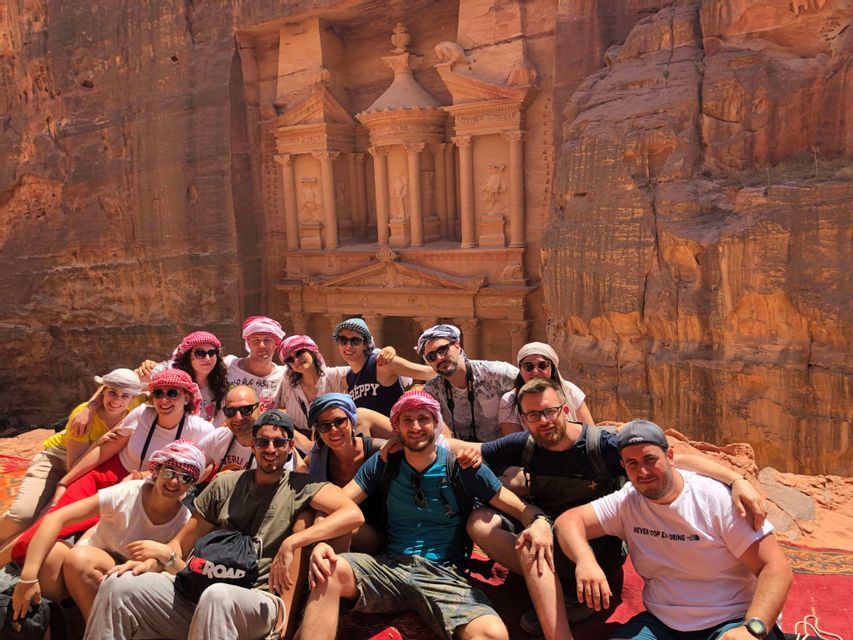
The Treasury of Petra
His photo is very famous and if you don't know the history of the place you tend to think that Petra and the Treasury of Petra are the same thing, but that's not the case. The Treasury of Petra is actually the tomb of the Nabataean king Aretas III (about 87-62 BC), the most imposing, majestic and best preserved tomb in the entire archaeological complex of Petra. Petra is one of the "Seven Wonders of the Modern World" and has been declared a UNESCO World Heritage Site, the ancient Nabataean city develops between red stone canyons carved by wind and water and has come down to us thanks to the work of the archaeologist Johann Ludwig Burckhardt who discovered it in the 19th century. Walking for about 2 km along the sinuous Siq, a narrow canyon with a thousand shades as many as the metals that make up the rock, you arrive at the Treasury, which opens up before you unexpectedly. We advise you to approach the railing and look down - there is another floor! This tomb carved alive inside the rock is bigger than it looks. Continuing our exploration along the main route, we can come across other minor tombs, the Roman amphitheater and the remains of other buildings that testify to the contact of the Nabataeans with the Greek and Roman peoples; if you feel like climbing a few hundred steps, you will find another monument carved in stone waiting for you that will leave you speechless: the Monastery. The archaeological site provides an infinite number of paths to be explored in every corner and is so extensive that it is estimated that it would take a month to discover it entirely! You may have also heard of Petra by night, an event held only on Mondays, Wednesdays and Thursdays at a cost of JD12, departing from the visitor center at 8.30pm to walk through the Siq in a suggestive candlelit setting. A stop in Petra of at least a full day is a must, our suggestion is to spend at least 8 hours!
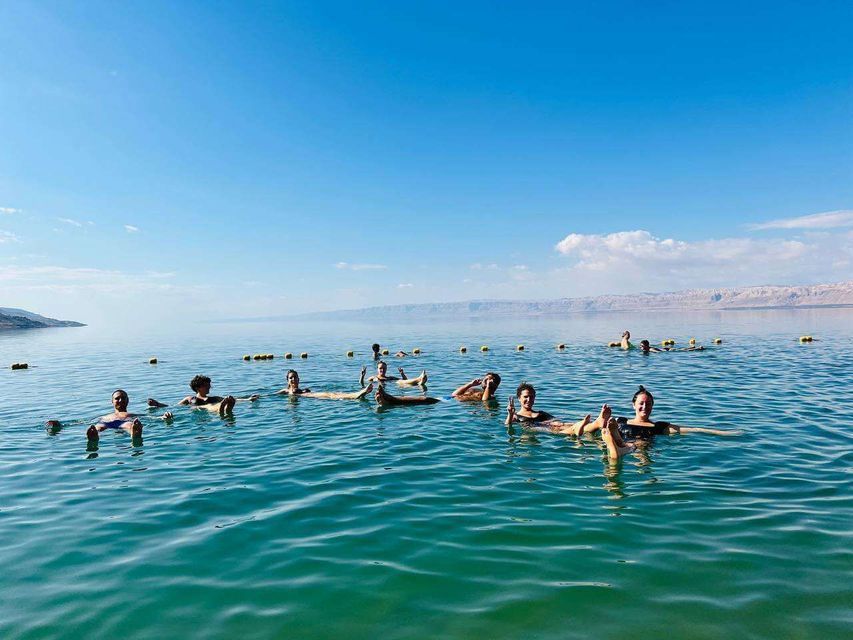
Death Sea
Let's start by specifying that despite the name it is not a sea, but a lake and is famous for two main reasons, its lethal salinity and its position below sea level. We are located at -420m below sea level - along the way you will also notice a monument to signal you the 0 point above sea level, from that point your ears may plug up like when you go to the mountains, it's normal. Its waters, on the other hand, reach a salinity of 30% (consider that the salinity rate of the sea usually reaches 4%), this implies that there are no life forms that inhabit it, not even bacteria! But we all know why we want to go swimming here: is it true that you float in the Dead Sea? Of course it's true, in fact, you also have to be careful not to roll over and use your abs for balance. A great advice we want to give you is not to shave in the 24 hours before taking a bath: any wound that comes into contact with such salty water burns a lot, listen to us. Before diving however, in all the points where it is accessible - usually it is necessary to purchase a daily entrance to an accommodation facility that overlooks its shores - you will find the famous mud of the Dead Sea available for a beauty treatment that will make you the skin of a child, it is said that passed on the hair work wonders!
Red Sea
Normally when one thinks of the Red Sea, the immediate association takes us to Egypt, but Jordan is also bathed by these waters and enjoys a coral reef that has nothing to envy to the Egyptian one: we are in Aqaba! This ancient city of transit for the merchant caravans that took refuge in its fort that can still be visited today, has developed into a touristic level with resorts and hotels for those who want to explore the underwater life of this area. Closer to shore, you can snorkel to see colorful fish and coral of all shapes at Rainbow Reef North. Instead, as you dive deeper towards Kiwi Reef and Tala Bay, you may encounter stingrays, turtles, octopus, and even seahorses. However, there are two unusual guests lying on the seabed full of colored corals, two shipwrecks. The wreckage of the Cedar Pride, an 80-meter merchant ship sunk 30 years ago, and the wreckage of an American anti-aircraft tank are now home to many tiny fish of a thousand hues. The best way to get to these places is to trust the local diving schools and participate in the boat trips they organize. However, for those who prefer to stay on the beach, it is important to know that there are two main beaches: the public beach and South Beach. The public beach is located in the center of the city and is frequented mainly by locals, so it is not possible to wear a bathing suit. However, with a 5-minute taxi ride, you can move to South Beach, the beach of the resorts and hotels, where you can instead enjoy the beach as we are used to in the West.
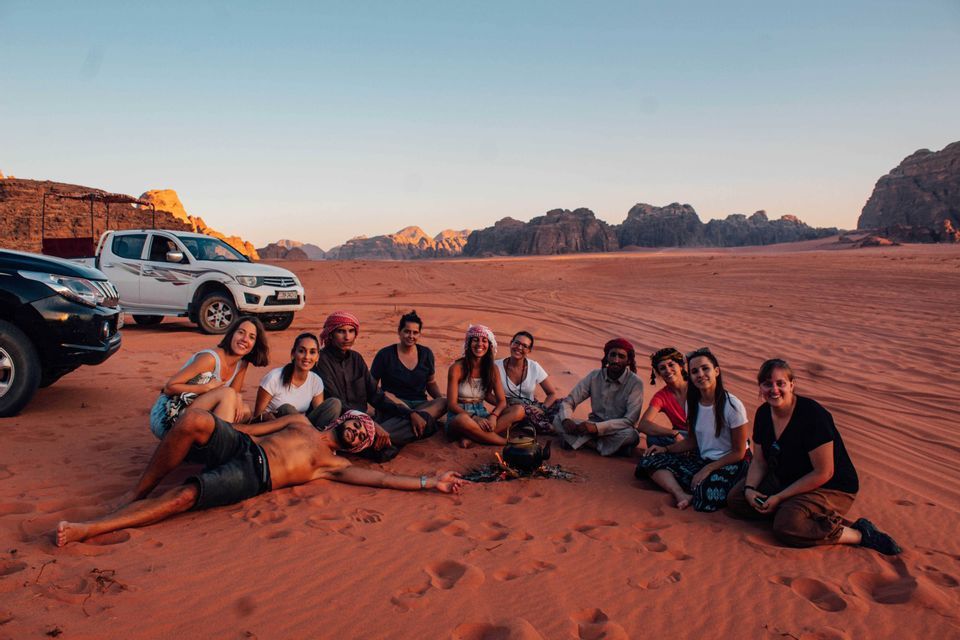
Wadi Rum
It's called a desert, but there are very few sand dunes, only the red ones in Wadi Um Ishrin, which can reach 20 meters. The Wadi Rum desert is more like the photos we get from Mars: 720 square kilometers of red rock walls carved by wind and water over the centuries that have formed very large canyons or narrow gorges to explore. The easiest way to do it? A jeep excursion with Bedouin guides, who know this desert perfectly. Both the fastest and most fun way to reach its highlights, the must-see attractions in Wadi Rum are definitely: the rock arches of Umm Fruth and Burdah that you can scale with a little agility and attention; the Nabataean temple from the 1st or 2nd century AD. dedicated to the deity Lat that houses the Thamud graffiti and the Lawrence spring, an oasis in the desert, an area of trees and shrubs that emerges in the arid desert thanks to the aquifers that gush underground. To better complete this experience, we recommend you spend a night in one of the tented camps also managed by the Bedouins, it will be an opportunity to learn about their traditions, their cuisine trying the zarb, the barbecue cooked in the sand, and admiring the starry or moonlit sky without light pollution. Unforgettable emotions are guaranteed! Not a drilo, our trips include both the night in the camp and the jeep excursion, we are serious when we say that they are not to be missed!
Jerash
First Nabataean city, then Roman colony of the Syrian governorate, the city of Jerash is the best preserved testimony of the Roman presence in Jordan. Archaeological excavations have brought to light monuments such as the Forum, the amphitheater, the hippodrome and Hadrian's Arch. In the Forum we find the remains of the Temple of Zeus, the main one in the city, the baths and the original paving of the 800-metre-long cardo. To the south of the city, however, the Arch of Hadrian and the hippodrome recall, the first the visit in 129-130 BC of the homonymous emperor, while the second the place where 15,000 spectators gathered to watch the chariot races and the athletic competitions. Nowadays we can also access the stables and rooms where the athletes used to retire in the basement. If you think that we are in the Middle East, it is something spectacular. It is the testimony of the history of a country founded on coexistence, contamination and collaboration between culturally and religiously different peoples, which however has generated monumental and archaeological riches to be discovered, together with its unique naturalistic wonders.